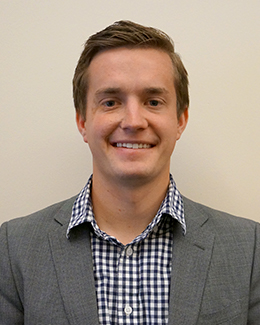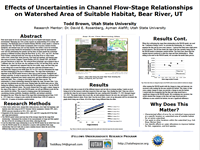iUTAH Team - Undergraduate iFellows

Todd Brown
Utah State University
Mentors:
Faculty: David Rosenberg, USU
Graduate: Ayman Alafifi, USU
Research Focus:
Research Focus Area 3
Major:
Human Movement Science
Biography:
Todd Brown is a junior studying Human Movement Science with a minor in Chemistry. Upon graduation he plans to attend medical school and apply the skills he learned doing research. Todd is the USUSA Service Vice President for 2016-2017 and loves to serve people. When Todd is not in class or doing research he enjoys hiking, camping, snowboarding, playing the guitar, and reading.
iFellow Presentation:
Effects of Uncertainties in Channel Flow-Stage Relationships
on Watershed Area of Suitable Habitat, Bear River, UT

Presented by: Todd Brown
July 2016
Weekly Recap:
Week 1 | Week 2 | Week 3 | Week 4 | Week 5 | Week 6 | Week 7 | Week 8 | Week 9 | Week 10 | Week 11
Week 1: May 16-20, 2016
This week was a big learning week and reviewing week. I went through the past Bear River Fellow’s work to organize and get myself oriented. I also met with Ayman Al Afifi to learn more about his work so I can learn how to apply it to my work. Lastly, I have been compiling a list of the different river widths for different sites we are working on, this includes the various transects we took with the ADCP.
Week 2: May 23-27, 2016
This week I worked on preparing data for the wash module that Ayman Al Afifi has been creating. I specifically 1) processed each transect that we took in 2015 with the ADCP so we could easily see all the data and the difference between them. 2) Finished collecting all of the river widths for the Confluence and Morton site. 3) Found the residual of flow and stage from our actual readings, and the distance made good readings. We will be testing the data soon to determine how the difference in flow or river width changes overall water use.
Week 4: June 6-10, 2016
This week I worked a lot on the stage vs. flow data on the confluence. I still have a lot to do, but I have been calculating the residual while taking into account the error on the data. From this data, we will be able to better determine the affect flow has on the river. I also have been writing my introduction and methods and working on the research assignments on canvas. I also started doing some literature review on previous work done on the Lower Bear River.
Week 5: June 13-17, 2016
This past week went really well! It started off with a great cohort session, practicing our presentations and also going to the Provo River to practice taking data was fun and educational! This week I spent more time working on the stage flow relationship and started finishing it up. Next step will be to graph it. I also did a lot of literature review this week of past work that has been done on the Lower Bear River and read over Ayman AlAfifi’s paper explaining the WASH model. I also spent some time learning about the interactive WASH model and learning how it works better.

Here we are learning how to filter river water to test
different substances in the Provo River
Week 6: June 20-24, 2016
This past week was an amazing week for research! I was able to make multiple graphs for my recent research I have been working on. After finding the residual of the flow for multiple transects, I then made a sheet on excel showing a random transect and made a graph showing the residual for our Confluence and Morton sites. I was also able to make graphs for Stage Vs. Flow for the Confluence and Morton for each random transect and also I made a bar graph for each slope for the Confluence and Morton sites.

Figure 1: A little look at the graphs and assignments I have been working on in excel.
Week 7: June 27-July 1, 2016
2016 iFellow Todd Brown describes the research he is working on at Utah State University for the summer: organizing and perfecting data to put in the Watershed Area of Suitable Habitat (WASH) Model, developed by USU Ph.D. student Ayman Alafifi.
Week 9: July 11-15, 2016
This week was a great week for research! A couple of great things happened this week. I was able to run my results I have been receiving through the Watershed Area of Suitable Habitat (WASH) model. After running the WASH model, I was able to see a 34 m3/month difference of available area of suitable habitat.
On Wednesday I was able to go with a small research group at Utah State University and travel to Idaho and tour some hydrology buildings and systems. It was a great opportunity to learn more about watershed systems.
Lastly, on Friday, we had the opportunity to share what research we have been working on. It was a great opportunity to explain to everyone the research I have been working on in the past couple of months. The feedback I received was very helpful.
Week 11: July 27-31, 2015
This week was a great but sad week. It was great because I got to present my research with everyone. I loved sharing my results with everyone. I also got to write a paper to share. Most of my work this week has been doing literacy review and also preparing to share and write my paper. It was sad because it was the last week of iUTAH. I would like to thank everyone at iUTAH for helping the researchers and myself do this amazing work.
All content provided on this iUTAH Team - Undergraduate iFellows weekly recap is unedited, updated by each participant to provide a review of their progress, and is for informational purposes only.


